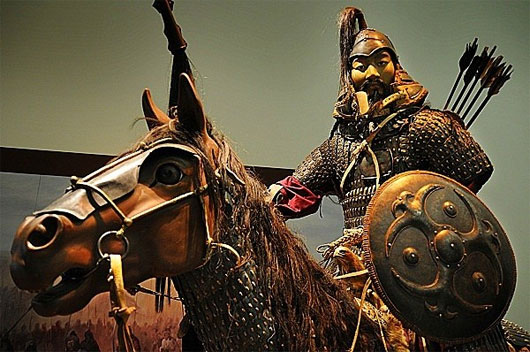The mystery behind the success of Genghis Khan
The strong development of the Mongolian empire under the rule of Genghis Khan can be attributed to climate factors . This is the conclusion of an American study published in the Journal of the National Academy of Sciences, March 10.
Neil Pederson and Amy Hessl, West Virginia University's botanical history experts and research authors, recreated weather patterns for 11 centuries from 900 to 2011 through a round-the-clock study growth on Siberian pine trees in central Mongolia.
The results show that the flourishing period of Mongolia under Genghis Khan coincided with the period of unusually mild regional climate lasting more than 1,000 years. Warm temperatures with high humidity from 1211 - 1225 are likely to promote pasture production, providing the empire of Chengshu Khan with abundant energy and abundant resources to lay the foundation for the expedition.

Artwork: gamek.vn
The study also found that before the reign of Genghis Khan, Mongolia experienced a period of severe drought that lasted for 10 years. The transition from drought to wetness suggests that there is a high possibility that climate weather plays an important role in the strong rise of the empire. According to expert Hessl, the climate is not the only factor, but it is certainly a force to help the talented leader develop the military, focus his power and bring his country to the top position.
Previously, the scientific community had many studies on the relationship between climate and the survival of civilizations. However, this is one of the few studies that goes into the positive aspect when climate plays a role in promoting the development of an empire. The new study also goes against some previous comments that suggest that the expansion of Mongolia stems from an engine to escape harsh conditions in the homeland.
As the founder of the Mongolian Empire, Genghis Khan is considered one of the most prominent and important leaders of world history. Under his reign, Mongolian territory stretched from Asia to Europe including the region now known as South Korea, China, Russia, Eastern Europe, Southeast Asia, India and the Middle East.
- The secret tomb of Genghis Khan is about to reveal
- Unexpectedly about the role of women under Genghis Khan
- Shocking revelations about the mighty warrior of Genghis Khan
- The mysterious screen about the burial place of Genghis Khan
- Journey to find the tomb of Genghis Khan
- Dai Viet's power is seen from the best of Nguyen Mong Emperor
- 10 little things to know about the notorious Mongol leader Genghis Khan
- The biggest battle of Genghis Khan's military career
- Discovering the stronghold of Genghis Khan in Mongolia
- More than 800 million Asian men are descended from 11 ancestors
- All men, why did Genghis Khan give each soldier a set of silk underwear?
- The mysterious resting places of thousands of emperors and great emperors
 'Fine laughs' - Scary and painful torture in ancient times
'Fine laughs' - Scary and painful torture in ancient times The sequence of numbers 142857 of the Egyptian pyramids is known as the strangest number in the world - Why?
The sequence of numbers 142857 of the Egyptian pyramids is known as the strangest number in the world - Why? History of the iron
History of the iron What is alum?
What is alum?